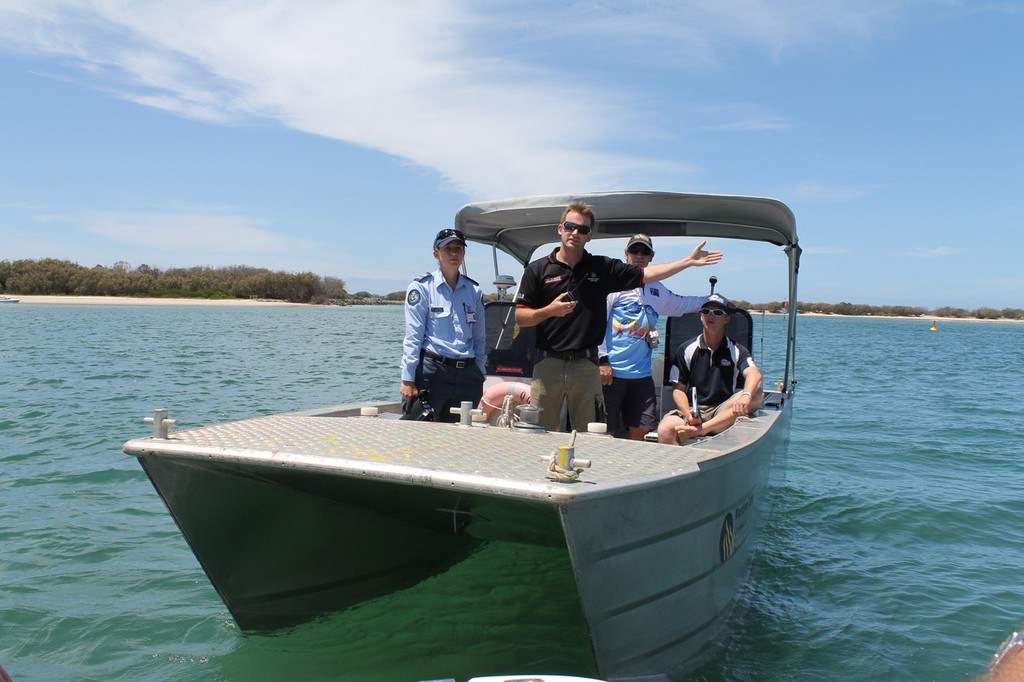Marine Queensland explains importance of Australian Builders Plate
by Jeni Bone on 26 Oct 2012

MSQ Doug explains the rigours of testing Jeni Bone
Marine Queensland and MSQ hosted a day on the Gold Coast Broadwater for south-east Queensland marine media, demonstrating the series of tests recreational boats up to 6m go through to pass compliance to Australian Standards and emphasising the importance of the Australian Builders Plate to all manufacturers, dealers and buyers.
The workshop and on-water component aimed to assist boating journalists conducting boat tests to ensure they look beyond the PR spiel, understand what compliance encompasses and ask the right questions.
'This is a Marine Queensland and MSQ initiative to educate and inform industry to ensure vessels manufactured and sold in Queensland are compliant with Australian Standards – meaning the safest possible product for our customers,' said Don Jones, CEO of Marine Queensland.
The on-water testing of vessels included checking positioning of navigational lights, a swamp test, stability tests and at speed turn tests, showing journalists exactly what vessels go through to prove compliance.
The Australian Builders Plate is a joint initiative of industry and government through the National Marine Safety Committee. A national standard was developed following an extensive consultation process which included workshops and meetings around Australia with the Australian Marine Industries Federation, boating industry associations, boat builders, manufacturers and importers.
As Doug Matchett, Senior Naval Architect with MSQ explains: 'The ABP came about as a result of coroner’s inquests. In Queensland, data showed there were around 10 fatalities per annum – that’s five per 100,000 vessels.'
There are on average 80 deaths and nearly 1,000 people admitted to hospital each year as a result of boating incidents in Australia.
In Europe, manufacturers collaborate to a CE Mark under the European Recreational Craft Directive, without which it is nearly impossible to sell a boat, asserts Matchett. 'In the US, there’s the ABYC Standards and NMMA plate, all accepted by industry and the boating public.'
In 2006, the National Marine Safety Committee put together a regulatory impact statement for recreational vessels which highlighted that the primary vessels involved in fatalities were dinghies (57%), open motor boats and half cabins. Of these tragedies, 31% of the vessels were overpowered, 24% were overloaded and 12% of those less than six metres had inadequate stability or buoyancy.
At 36%, capsize was the most common initial event in all fatal incidences. The regulatory impact statement estimated that fatal and serious injuries associated with recreational boating costs Australians about A$52 million each year.
The Australian Builders Plate is a national initiative that aims to make boating safer by providing vital information about the capacity and capability of boats. It was formulated to ISO standards, currently AS1799 (2009).
The Australian Builders Plate requires boat builders, importers or competent persons (a person who has acquired through training, qualification, experience, or a combination of these, the knowledge and skills to enable that person to competently determine and approve the information on a builders plate) to determine boat-specific information and display it on the plate in a standard format.
The information that needs to be provided on an ABP includes:
• recommended maximum engine power rating and engine weight for outboard engines
• recommended maximum person capacity and maximum load
• buoyancy information, for vessels under six metres
• a warning statement about the alteration of the boat.
There are two types of builders plate, one for boats under six metres in length and another for boats six metres or more. The key difference is that vessels under six metres need to display buoyancy information, either basic or level flotation.
The information supplied on the plate will enable boat users to make more informed decisions when purchasing, as well as encouraging appropriate and responsible use of boats.
In the case of accidents, the bulk of which are caused by human error, investigators begin with making sure the boat was being operated in accordance with the details on the ABP, or check that it has one.
'If a boat is proven to be non-compliant, or misrepresented, the manufacturer, importer or seller may be culpable,' says Doug, adding that journalists can ask to check the ABP on any boats they trial 'and it should be clearly visible, at the helm, near the steering so the skipper is able to see it'.
ABP evolved from statistics gleaned from investigations and audits, as well as industry concerns manufacturers and importers would be liable for any incidents. Marine media proponents need to do their part to include ABP on their inventory of checks during a sea trial, and ensure their readers/viewers are aware of the role of the ABP and its aim to secure their safety on the water and once they sell their vessel.
More at http://www.nmsc.gov.au/recreational_boating/index.php?MID=24&CID=24
If you want to link to this article then please use this URL: www.sail-world.com/103220